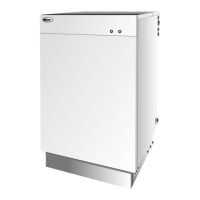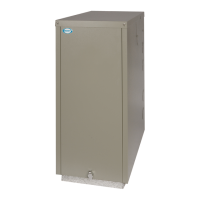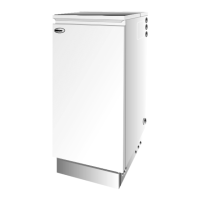15
Combi 70 & Combi 90 Oil Boilers
See Fig. 10
Grant boilers have high operating efficiencies. Care
must be taken to ensure the flue system is suitable for
the low flue gas temperatures.
1 An insulated flue terminating in a down draught
free area, i.e. at least 1 m above the point of exit
through the roof or preferably above the ridge
level, will normally provide the necessary draught
of at least 8.7 N/m
2
(0.035 in wg) as measured
close to the boiler connection. If a draught of 37 N/
m
2
(0.15 in wg) or more is measured, then a
draught stabiliser should be fitted in the flue.
2 The flue terminal must be at least 600 mm from
any opening into the building, and 600 mm above
any vertical structure or wall less than a horizontal
distance of 750 mm from the terminal.
3 If an existing chimney is used, it must be lined with
a stainless steel liner for use with fuel oil. The top
and bottom of the annular space must be sealed and
the void filled with a suitable insulating material to
reduce cooling of the flue gases.
4 If a rigid flue is used either internally or externally,
it must be of the twin wall type with a stainless
steel inner skin suitably insulated and weather
proofed.
5 The flue diameter must be as specified in
section 2.1 for the size of boiler in question.
6 The flue must be run upwards following as near a
vertical route as possible. Horizontal runs must be
avoided and no bends should have an angle of more than
45° from the vertical. There should be at least 600 mm
of vertical flue above the boiler before the first bend.
7 A sealed cleaning door must be provided near the
base of the flue.
8 The exposed flue pipe between the boiler and the
chimney must not be of an asbestos material and
aluminium must not be used in any part of the flue.
9 If the draught conditions are satisfactory, the flue
should terminate with a standard cowl. Where the
flue cannot terminate above the ridge of the roof,
use an 'OH' or similar type cowl where
downdraughting occurs.
Ridge vent terminals must not be used.
10 Refer to the locally applicable Building
Regulations, BS 5410:1 and OFTEC Installation
Requirements (Books 2 and 3) for further guidance
on conventional flue systems.
3 - GENERAL BOILER INFORMATION
Conventional flue system
3.7
11 To allow for flue gas analysis and combustion
testing, a test point is provided in the cleaning
door.
Fig. 10 - Typical conventional flue with brick chimney

